Human Anatomy Fundamentals: Basic Body Proportions
In this human body drawing tutorial, you'll learn the basic anatomy drawing techniques. If you’ve practiced capturing energy in the previous tutorial, you’ll have acquired a good feel for loose body drawing. Now, we’re going to start giving structure by studying the body with a more scientific eye.
Let me say that it will take many sessions to cover the wonders of the human body. It's among the most sophisticated animal structures in nature, and one of those with the most variations. The aim is to become familiar with all kinds of proportions when drawing bodies.
What You'll Learn in This Human Body Drawing Tutorial
- How to draw a body step by step
- How to draw bodies' basic figure
- Drawing a body's basic profile
- Basic human body drawing outline
- Human body proportions drawing
- Body drawing practice exercises
What's in this article:
1. How to Draw a Body: The Basic Figure
Step 1: Create Your Chart From Heads
Let's begin with the basics of human body drawing. A well-proportioned figure, regardless of variations due to gender and such, is defined by the alignment of the joints, which is invariable (that is, we perceive something odd if it does vary). This is our groundwork for the proportions of a human body diagram. Draw your own chart with me as we go—it really helps with learning the material.
To learn how to draw a body, we start with the head. Start by drawing an oval or egg shape (pointy end down) for a head, and mark down eight measurements, the last one being the ground.
The measurement (ideal male height = eight heads) was set down during the Renaissance as an idealization of the human form. It’s rather obvious that very few people are actually eight heads tall (even Northern Europeans, who served as the basis for this model, are closer to seven heads), but this is still the best model to start your anatomy drawing, as it makes it easier to grasp the alignments.
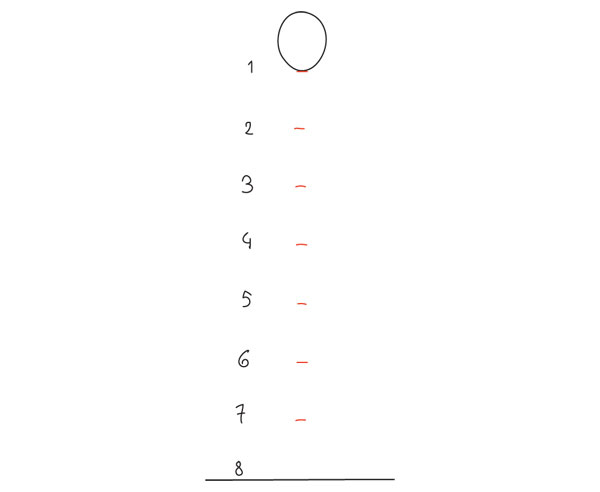


Step 2: The Pelvis
Add the pelvic bone next, simplified as a flattened circle between marks 3 and 4, with the hip joints sitting on 4. Its width is roughly 1.5 to 2 head-widths. You can now add the spine to your body sketch, connecting the head to this most important part of the body, its center of gravity and stability.
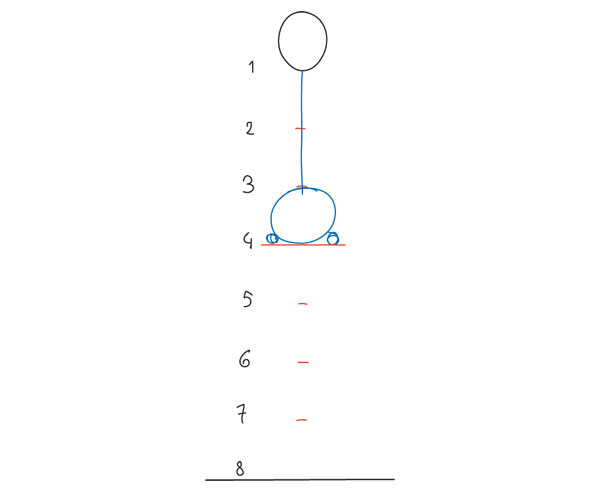


Step 3: The Legs and Knees
Let’s assume the figure in this human anatomy drawing is standing with the feet vertically aligned with the hip joints. The knee joints sit on mark 6, as that line corresponds to the bottom of the kneecaps.
When the leg is stretched out, the knee joint is placed on a straight line with the hip and ankle (left). But this straight line is virtual: to complete the leg, connect the hip joint to the inside of the kneecap, and then again, the outside of the knee to the inside of the ankle (right).
This is a very simplified but accurate representation of the actual bone structure, and it helps capture the natural look of the human leg when drawing bodies, which tapers in from the hip, then staggers out at the knee, and tapers in again. It also helps with placing the muscles of your anatomy drawing at a later stage.



Step 4: The Ribcage, Nipples, and Belly Button
The ribcage-lungs group is the third important volume of the body, after the head and the pelvis. Simplified, it is an oval that starts halfway between 1 and 2, down to mark 3. However, it's best to chop off its lower part as shown here to imitate the actual rib cage, as the empty part between the two volumes is important: it is soft and subject to change (flat belly, soft belly, wasp waist) and it is also where the most torsion and movement happens in the spine.
When drawing a body, it's good to be aware of that and not to attach the torso and pelvis together like two blocks, as that would "block" your body drawing’s range of motion. The width of the oval is roughly the same as the pelvis for now.
Two more details here: the nipples fall on mark 2, just inside the sides of the head, and the belly button on mark 3.
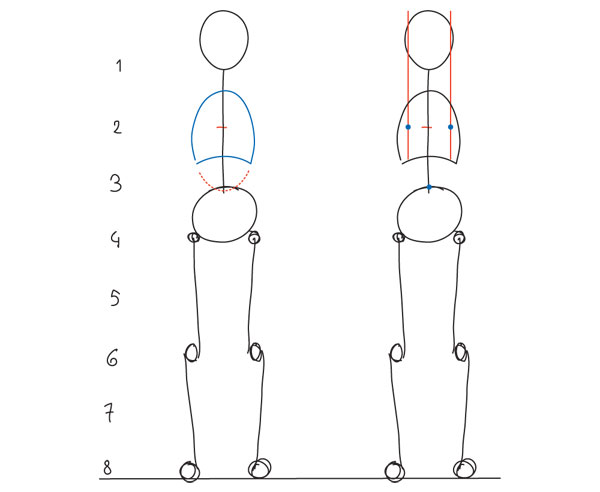


Step 5: The Shoulders
The shoulder line is about halfway between marks 1 and 2 of your body sketch, with the shoulder width 2 to 3 head-widths, but its apparent position can vary a great deal. To begin with, it’s slightly curved down, but in tension the shoulders tense up and the curve can itself turn up and look higher.
Furthermore, the trapezius muscle, which from the front appears to connect the shoulder with the neck, is highly individual. If it’s very muscular or carries much fat, it can make the shoulder line look so high there’s no neck. Inversely, an underdeveloped trapezius, often seen in very young women, gives the impression of a long neck.
This brief digression into non-skeletal details is to ensure there's no confusion between the actual position of the shoulder line and its apparent placement in a fleshed-out body, some examples of which are shown on the human anatomy drawing below.


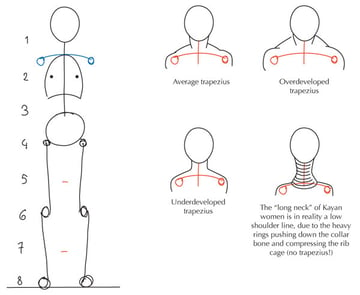
Step 6: The Arm, Wrists, and Hands
Finally, let's learn how to draw a body with arms. The wrists are on mark 4, slightly below the hip joints, which sit on it (you can test it out for yourself by standing up and pressing your wrists against your hips).
The fingers end roughly at mid-thigh, which is mark 5 on the body sketch. The elbows are a slightly complicated joint that we’ll examine in detail later, but for now it’s helpful to mark them in your anatomy drawing as elongated ovals sitting on level 3.
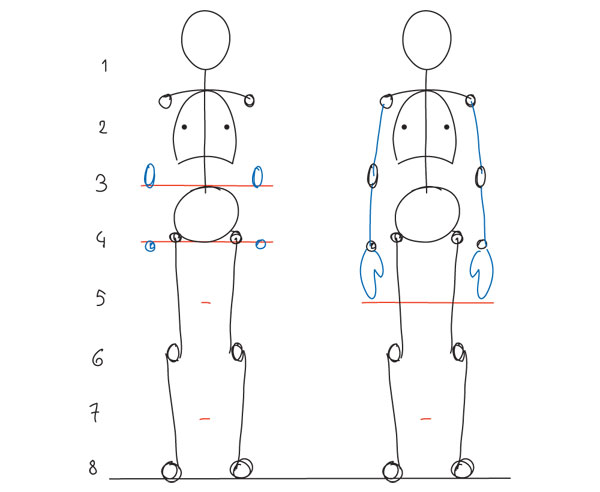


We’re done with the basics of how to draw bodies... almost. Before summing this up, let’s extend those marks into lines and see how this works in a profile body drawing.
2. How to Draw a Body: The Basic Profile
The next step in learning how to draw a body is the profile. Start by drawing the head again, the same egg shape but with the end pointing diagonally down, and drop a vertical line from the crown to the ground.
In an erect posture, you can place the pelvic bone (a narrower version of the head’s egg), the shoulder, and the knee of your human body diagram roughly on this vertical line. They are on the same level as before: all the joints are, but the others are not on the same plane as these.
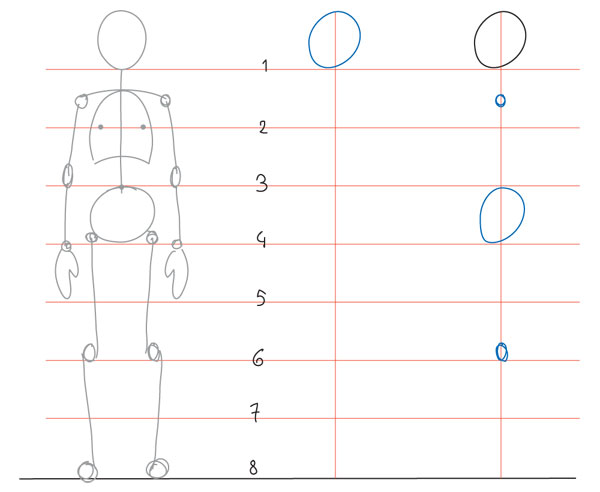


Step 1: The Spine in Profile
From the side, the spine is revealed as being shaped like a flattened "S". From the base of the skull, it moves down and back till it reaches its furthest point at the level of the shoulders (between the shoulder blades). Note the shoulder joints are ahead of the spine! This is because, again, the shoulder "line" is in reality an arc: the medallion shows a top view of it.
The spine then comes back forward, and peaks again (inward) a little above the pelvis (the small of the back, which varies in depth and can make for an arched back). Finally it changes direction again briefly and ends in the coccyx or tailbone.
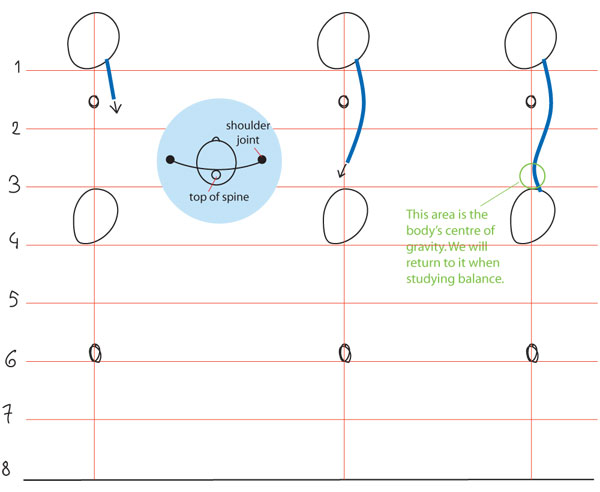


Step 2: The Ribcage and Legs in Profile
The ribcage is closely attached to the spine and, in a reasonably fit body standing erect, the chest is naturally pushed forward.
The hip joint is ahead of our vertical axis, and this is counterbalanced by the ankle being a bit behind it. So our hip-knee-ankle line is slanted backward, and staggered again: from the hip joint to the front of the knee joint, and from the back of the knee joint to the ankle.
The overall effect of this posture is a visual arc from head to chest to feet (in green), and when it’s flattened or reversed, we perceive an uncertainty or slouch in the posture.



Step 3: The Arms in Profile
Finally, the arms of your human body drawing. The upper arm falls fairly straight from the shoulder, so the elbow can be aligned with the latter (or fall slightly backward).
But the arm is never fully stretched when at rest, so the forearm is not vertical: the arm is slightly bent, and the wrist falls forward, right over the hip bone. Also, when the hand is relaxed, the fingers curl a little, as shown here.
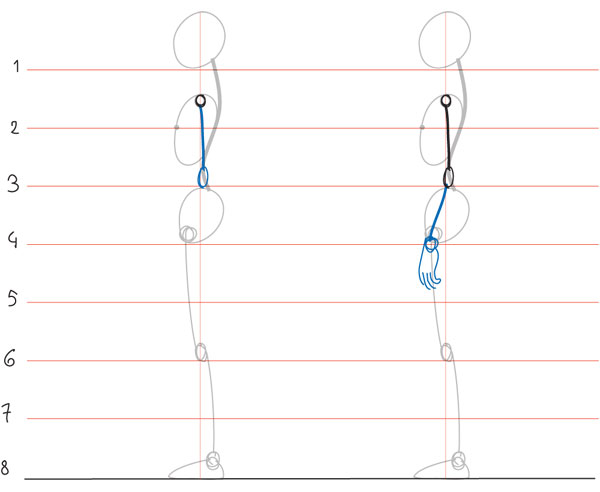


3. How to Draw a Body: Summary
This completes the basic, undifferentiated human body drawing tutorial. Here’s a human body diagram to sum up all the human anatomy drawing outline techniques we reviewed:
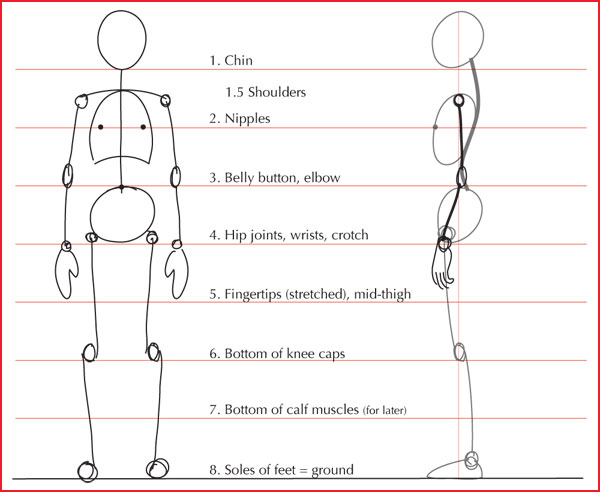


Human Body Proportions Drawing Reminders
The following examples of how to draw bodies are a few useful visual reminders based on human anatomy. They come in handy when your human body drawing is not standing upright.



4. How to Practice With Body Drawing Exercises
We’ve covered a lot of material in this human anatomy drawing tutorial. Now is a good time to pause the studying and familiarize yourself with this basic figure and the principles of drawing a body with the right proportions. Then, we'll move on to the differences between male and female structures (and others).
For instance, you can integrate this new knowledge into your daily human body sketch practice by overlaying a quick energy sketch with this correctly proportioned basic figure.
Tips on Proportions When Drawing Bodies
When I'm drawing a body, I consistently start with the head. But it doesn’t really matter what part you start with when drawing bodies, as long as you’re comfortable and get a good result. If you're unsure or are having a hard time learning how to draw a body, then I suggest trying with the head first.
Get used to drawing this basic figure of your human body diagram with a light hand, since the finished body will be built up over it. Traditionally, the final lines are inked and the guidelines then erased (hence the importance of a light hand), but even when I’m sketching with a ballpoint pen with the intent of inking on a different sheet by transparency, keeping a light hand ensures I can see what I’m doing.
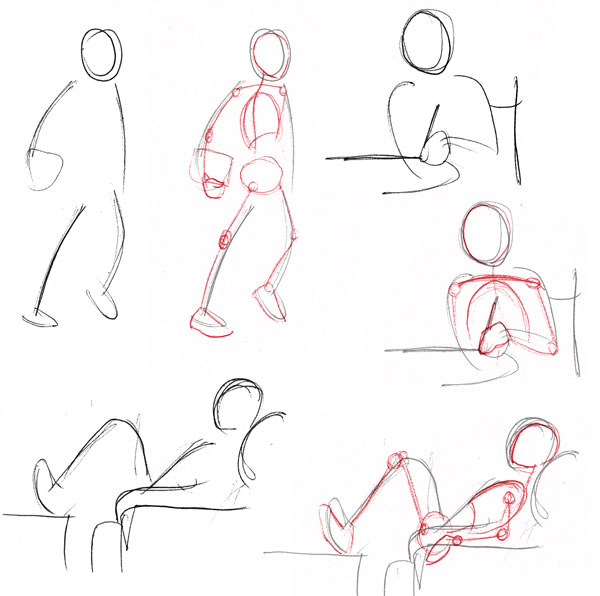


Discover More Awesome Human Drawing Tutorials
I hope you've enjoyed this tutorial about how to draw a body step by step. If you want to learn even more about how to draw bodies, we've got this great learning guide: Human Anatomy Fundamentals. There you'll find detailed human drawing tutorials and resources like these:


 Human Anatomy Fundamentals: Learning to See and Draw Energy
Human Anatomy Fundamentals: Learning to See and Draw Energy

 Joumana Medlej02 Oct 2013
Joumana Medlej02 Oct 2013

 Human Anatomy Fundamentals: Advanced Body Proportions
Human Anatomy Fundamentals: Advanced Body Proportions

 Joumana Medlej10 Dec 2013
Joumana Medlej10 Dec 2013

 Human Anatomy Fundamentals: Basics of the Face
Human Anatomy Fundamentals: Basics of the Face

 Joumana Medlej28 Nov 2023
Joumana Medlej28 Nov 2023

 Human Anatomy Fundamentals: How to Draw Hands
Human Anatomy Fundamentals: How to Draw Hands

 Joumana Medlej15 Jul 2014
Joumana Medlej15 Jul 2014

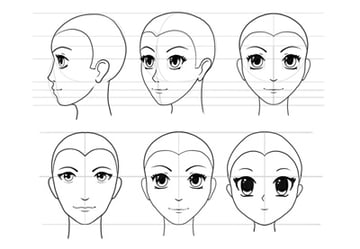 How to Draw Anime Heads and Faces
How to Draw Anime Heads and Faces

 Monika Zagrobelna08 Nov 2018
Monika Zagrobelna08 Nov 2018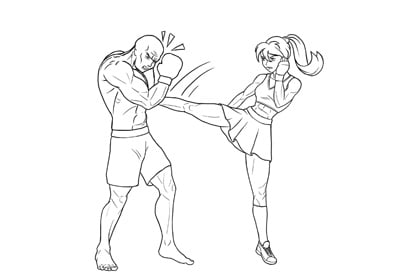

 How to Draw Anime Characters
How to Draw Anime Characters

 Monika Zagrobelna16 Oct 2018
Monika Zagrobelna16 Oct 2018

 How to Draw Natural, Textured, Afro Hair (How to Draw Curly Hair)
How to Draw Natural, Textured, Afro Hair (How to Draw Curly Hair)

 Daisy Ein08 Sep 2018
Daisy Ein08 Sep 2018

 How to Draw Disney Characters
How to Draw Disney Characters

 Monika Zagrobelna10 Sep 2018
Monika Zagrobelna10 Sep 2018
Editorial Note: This post has been updated with contributions from Maria Villanueva. Maria is a staff writer with Envato Tuts+.





